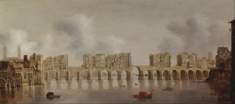





Docklands and the Thames,
Victoria Park to Paternoster
Square. Take a nostalgic
trip back to the East End in
the 1950’s or a stroll around
the Square Mile of the City
of London. It’s all here at
barryoneoff.co.uk
Copyright 2002 - 2024 ©Barry Carter. All rights reserved
LONDON BRIDGE the first Thames crossing
"London Bridge is falling down,
falling down, falling down”
London Bridge is falling down,
my fair lady".
Ancient nursery rhyme
The Romans
The River Thames was very much wider in the early days of Londinium. When the Romans saw it for the first time it was around five times wider than it is today. Because of the greater width it was also much shallower, with small islets forming at low tide. It was man expanding the banks outwards over the centuries that has narrowed and deepened the river. This explains why certain areas of London have such a high flood risk, being somewhat lower than the level of the water now. There is no doubt that the conquering Romans must have had a bridge crossing the river somewhere near today’s site. It may have started as a floating pontoon, then a more permanent wooden structure. Either way, they needed one for crossing, as well as defence purposes.The Early Bridges
In the early years there must have been many bridges erected and destroyed. The construction, I should imagine, was pretty primitive, especially after the disciplined army of the Romans left in 410 AD. Apart from the strong tides, the risk of fire was always there with what would have been wooden structures. Then there were the armies queuing up to invade Britain, via London. On one of the many invasion attempts by the Danes, in 1014, Ethelred the Unready, helped by King Olaf of Norway once again pulled down the bridge to divide the Viking forces. This gave us the song written by a Norse poet of the time: “London Bridge is broken down Gold is won and bright renown Shields resounding War horns sounding Hildur shouting in the din Arrows singing Mailcoats ringing Odin makes our Olaf win” The more familiar version at the top of this page only came about in the mid 17th. century. There is no way of knowing the exact number of times rebuilding took place during these early years but the last one was erected, apparently, in 1163 and was probably made of Elm. In 1176 a priest and architect, Peter Colechurch, planned a bridge of stone.Last of the Ferryman
In medieval times there was a ferry across the river near the site of the bridge. When the last ferryman, John Ovary, died his daughter, Mary Ovary, donated all her inherited wealth to build a convent on the site which was later to become known as St. Mary of the ovaries. This was later turned into a college for the priesthood. The priests set about building a wooden bridge across the Thames. They were also responsible for the maintenance of the bridge. The church was later named St. Saviours and in 1905 became what we know today as Southwark Cathedral. The earliest reference I could find for this bridge was dated 984 AD. when a woman found guilty of witchcraft was ordered to be taken to London Bridge and be drowned. Ten years after that, in 994 AD, King Ethelred defended London against an invasion by the Danes with the help of King Olaf. They pulled it down with long boats to stop the Danes crossing. How long the bridge had been standing before these events I am unable to say. There is a plaque on the South side of the river telling a bizarre tale about the death of John Ovarie. If you are unable to read the text from the photo click here for a text copy.John Rennie’s Bridge
After many plans were submitted for tender the proposal by John Rennie was accepted. Although his design was used, it was his son, Sir John Rennie who actually saw it through to completion. His father, unfortunately died before the building work was even started. On June 15th. 1825 the first foundation stone was laid. The first stone to be laid, on the City side of the river, was in December 1826. Once again, the old bridge was left standing while work was in progress, after a few alterations to some of the arches to allow water flow not to hinder the operation. It would allow access to traffic until demolished on completion of the new structure. It was completed in 1831, and William IV officially opened it on August 1st. The picture, from a painting in Guildhall Art Gallery, shows the demolition of the old bridge.Widening of the Bridge
In the latter part of the 19th. century there were repeated calls for the bridge to be widened. These demands were due to the ever increasing volume of traffic chaos caused by the vast numbers of vehicles using it. They were all ignored however, for reasons of finances, and the wish not to spoil the architecture. In 1902 plans were finally put into action and the bridge was widened. The alterations added four and a half feet to each footpath, and two and a half to the roadAnother bridge
In 1967 it was decided to replace the bridge once again. There were reports of cracks appearing and general decay during the previous forty years. Modern design technology allowed the bridge to have only two supporting piers in the water, making a much wider space for the waterborne traffic. The way they tackled the task this was to build the two outside lanes either side of the old bridge to allow traffic flow. The old bridge was then dismantled and the two centre sections put into place. It is a box girder bridge built from concrete and steel, designed by Lord Holford and engineers Mott, Hay and Anderson. It was opened by Queen Elizabeth II on March 16th. 1973. I have a real hatred of the stair design on the South side. Not only are the steps built at an angle, but the handrails are of a diameter much too large to get a hand round securely. On the North side an excellent spiral staircase was installed in 2016 giving easy access to the river. It has an information platform halfway up/downOff to America
When news of the intended demolition of Rennie’s bridge was announced there were protests from many quarters. Some even suggested restoring it to its old form including the buildings that were once part of it. An American, representing McCulloch Properties, put in a bid for the Rennie bridge of £1,250,000 and purchased it to take to the USA. It was divided into sections and marked out by numbers. The sections were then dismantled and shipped across the Atlantic. It arrived in California on July 5th 1968. After a 240 mile journey from there to its final destination the first stone was laid by the then Lord Mayor of London, Sir Gilbert Inglefield on September 23rd. 1968. It is still there today in Lake Havasu City, halfway between Phoenix and Las Vegas. It was rumoured that the Americans thought they had bought Tower Bridge but this is a myth. They knew exactly what they were purchasing.The first stone bridge
Construction work started just west of the old bridge, in 1176, with the wooden bridge left standing until building finished. This was just as well really, as the stone replacement took over thirty years to complete! It must have been a major feat of engineering when you think what was involved without the aid of modern day plant and machinery. The course of the river had to be diverted by digging massive trenches, from Radriffe to Patricksey in order to lay the foundations. Even so, they still had to pile drive from floating barges. This may have had a bearing on the uneven measurements, it must have been impossible to maintain a position while fighting the tides, even with the diversions in place. There were nineteen arches contained in the structure, none being of the same dimensions. Whether this variation in widths was due to the unevenness of the river bed preventing equal placement of the foundations, or just bad workmanship, I cannot say. Because the nineteen supports took up almost two thirds of the width of the water it created a sort of weir, with the water being forced through the arches at great speed. After a slower flow on the upriver side of the bridge it accelerated into near rapids on the down side.Saint Thomas’s Hospital
In the centre of the stone bridge was placed a church, by the side of the roadway, built upwards from the base of the supporting pier. This was named St. Thomas’s, after Thomas Becket who was murdered a few years earlier by soldiers who had heard King Henry II muttering that he wished him dead. They unfortunately took the words seriously! There were also gatehouses with drawbridge and portcullis. The money for the building work was raised by various taxes, and also payment from allowing the erection of many buildings along its length. It was completed in 1209, and who would have imagined that it would stand for a period spanning six hundred years before being replaced?Fire and Disaster
On the night of July 10th. 1212 three years after the completion of the first stone bridge, fire broke out on the south side of the river in Southwark. People ran across the bridge to help quench the flames, but this action was to be regretted. Bear in mind that by this time numerous buildings had been erected upon the bridge. A strong wind fanned the flames and sent sparks across the river. This caused the buildings at the other end of the bridge to ignite, trapping the people in the middle of the bridge. There was only one way out, over the side into the Thames, where a large number of boats had gathered hoping to be of assistance. The vast number of townsfolk attempting to board the vessels caused some of them to sink. The number of bodies recovered was around 3,000 but this did not include the people incinerated in the fire, who's bodies were never found.More disaster
In 1282, seventy years after the fire, the bridge suffered another disaster. Though this one did not claim any lives. During a bad winter with heavy snowfalls and thick frost, the elements attacked the main arches of the bridge. This caused five of them to completely collapse. Over the next few years it deteriorated and became too dangerous for general use. In 1381 the bridge was repaired using money raised by the churches. This was the same year that Watt Tyler and the rebels from Kent, as Stow called them, entered into London by way of the bridge. Apart from widening of the roadway in the eighteenth century, the bridge remained unaltered until 1825 when work was started more than 600 years since the building of the first one.







_by_Claes_Van_Visscher-1.jpg)

















